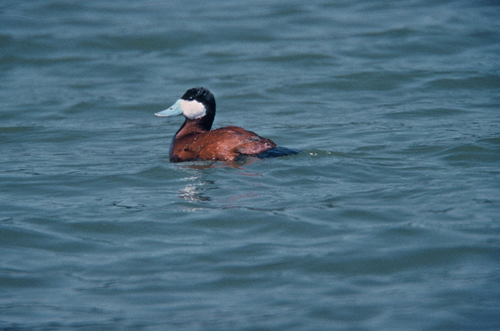
A Remarkable Duck of the Refuge
By Larry Hyslop

Ruddy duck drake, courtesy of the USFWS
Summer is not complete without a visit to the Ruby Lake National Wildlife Refuge, and my favorite part of any visit is watching the Ruddy Duck. Although I might not describe a Ruddy as beautiful, they are definitely energetic.
A Ruddy Duck is not the lithe and graceful Canvasback. Chunky is the best description for the Ruddy Duck’s shape, although the male, during breeding season, is a rich brown color. Their stubby wings make them more likely to dive and quietly re-emerge among reeds than fly away from my approach, since they need a long run across the water to become airborne. Their tail feathers end in spikes. While displaying, their tails are held absolutely vertical and fanned, exposing their white rear ends.
Their large heads are divided between black tops and white bottoms. But their most endearing characteristics are large, sky-blue bills used to filter food from the muddy pond bottoms.
During this summer’s trip to the Marshes, a ruddy duck drake swam along a wall of reeds, followed closely by a hen as he performed his bubble display. Breathing air was diverted into tracheal air sacs in the neck. His head was low and tucked in to exaggerate the swollen neck. He kept the sky-blue bill in the water as he rapidly smacked it against his swollen neck, producing drumming sounds and bubbles in the water. He ended his display with a belching call and a kicking splash.
If the Ruddy Duck hen was impressed by his efforts, and I do not see how she could not be impressed, she will later construct a nest lashed between reeds. But her method of raising young is no less unique than the drake’s display. Some of her eggs will be laid in other birds’ nests, including other Ruddy Ducks, Redhead Ducks and even Coots and Grebes.
Rod Wittenberg is Assistant Refuge Manager at the Ruby Lake National Wildlife Refuge. People often stop in the office to ask him the name of that “duck with the blue bill and spiky tail feathers”. Ruddy Ducks are commonly seen in the West Marsh Units, Unit 21, and the northern portion of the South Marsh as viewed from Brown Dike.
As the drake and hen disappeared among the reeds, busy with their own lives, I was reminded how lucky we are to have the Ruby Lake National Wildlife Refuge in our “back yard”.
Elko Daily Free Press, “Nature Notes”, 7/29/2011 © Gray Jay Press, Elko, NV
Return to Elko Nature Notes